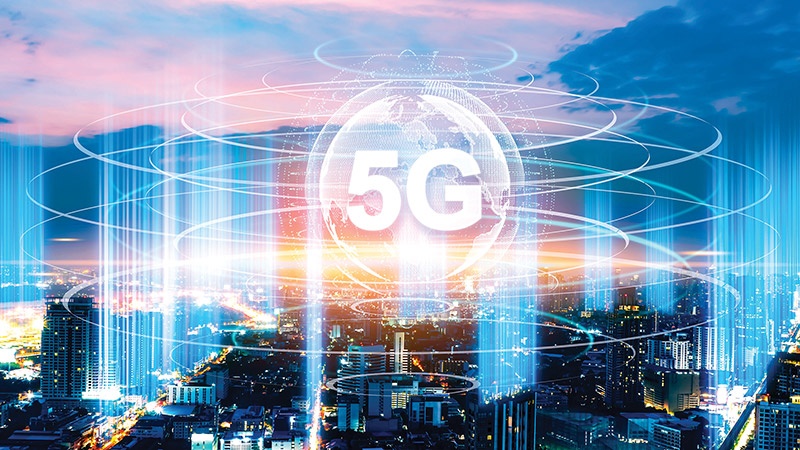Is Vietnam really ready for commercialisation of 5G?
 |
| Vietnam is gearing up to be 5G ready as soon as is feasible, Photo: Shutterstock |
Vietnam has long stated its plan to provide 5G coverage nationwide by 2030. The ability to offer all citizens high-speed internet connection at a low cost is a priority of national significance, according to the Ministry of Information and Communications (MIC).
Nationwide roll-out of 5G coverage will require a step-by-step approach. Major cities like Hanoi, Ho Chi Minh City, and Danang have been prioritised to deploy 5G due to their larger need for high-speed services and denser populations. Industrial areas which attract foreign investment have also been prioritised to facilitate the development of smart factories.
Viettel, MobiFone, and VNPT have been trialling 5G services with their users since November 2020. A recent test, jointly conducted by Viettel, Ericsson, and Qualcomm at Viettel Innovation Lab, successfully established 5G data transmission speeds of more than 4.7Gb/s – 40 times faster than 4G and more than twice as fast as the existing 5G network. Viettel’s tests confirm the incredible capacity of 5G ultra-short wave technology.
The MIC has been tasked to commercialise 5G in Vietnam. By all accounts, mobile operators will price services at rates equivalent to existing 4G services. Users will not be required to change their SIM cards. Vietnam’s digital economy totalled $14 billion in 2020, and the deployment of 5G is expected to boost this figure significantly.
Indeed, the overall contribution of 5G to GDP is forecast to reach 7.34 per cent by 2025. While, perhaps ambitious in terms of the timeline, Vietnam has high hopes for 5G on its medium-term horizon. Vietnam did miss its schedule for 5G commercialisation in 2021, so, perhaps some caution is warranted on timing.
With a view to accelerating digital transformation, the government has initiated various programmes to boost tourism management and promotions, infrastructure investment, digitisation of the postal sector, digitisation of the logistics sector, and e-commerce, among others. First and foremost, meeting the commitments of these government programmes is critical to the development of the sector, and enabling digital transformation on a meaningful scale.
Cooperation potential
Telecommunication infrastructure, including mobile and fixed broadband infrastructure, is defined as one pillar of the digital economy. The development of broadband infrastructure has enabled the development of all economic sectors. 5G promises to deliver broadband-level speed, wirelessly, to millions of users where they access it most – their phones.
Particular interest has been noted in the application of 5G technology to agriculture and the high-tech industry, including smart factories and smart cities. The Vietnam Telecommunications Authority plans to deploy 5G with priority going to industrial and high-tech parks, as well as high-density urban centres and central business districts of major cities.
As Vietnam, along with the rest of the world, transitions toward an increasingly digital economy, data and one’s ability to make use of it progressively become more crucial.
Improvements to Vietnam’s mobile and fixed broadband infrastructure will continue to contribute to the country’s development. Telecom infrastructure is key for the development of the digital economy. Tech like the Internet of Things (IoT), AI, big data, network security, digital identity, digital government, and electronic payment platforms all rely on widespread, fast, and affordable connectivity.
As technology advances, legal developments often lag. Recent and impending changes to Vietnam’s data protection law have the potential to restrict the free flow of data. The implications of data-intensive technologies powered by 5G are yet to be seen. The need for a clear and robust legal framework remains and is needed to bolster investor confidence and drive innovation.
The potential for cooperation between Vietnamese and foreign businesses is virtually endless. With high capacity and ultra-low latency, 5G will enable meaningful use of AI-enabled technologies and IoT applications across a range of use cases and sectors. As enterprises employ 5G as a means to process and analyse more data, revenues and valuations are expected to increase, as businesses become better equipped to monetise huge amounts of data.
Developments in technology powered by 5G will expand the mobile ecosystem to new industries. The global digital economy is projected to reach a value of $13.1 trillion by 2035. Much of its growth will be fuelled by 5G connectivity. Precision agriculture, construction and mining, digitised education, connected healthcare, smart manufacturing, intelligent retail, and connected smart cities are areas where development will be catalysed and enabled by 5G coverage.
Private 5G networks will revolutionise container ports, warehousing and logistics, airports, hospitals, hospitality, manufacturing, farming, and more.
In the healthcare context, for example, doctors and patients will be more connected than ever. Wearable devices will alert providers when a patient is experiencing symptoms. For example, an internal defibrillator could automatically alert emergency room cardiologists of a patient experiencing symptoms, allowing physicians to prepare for the incoming patient – complete with a full record of data collected by the device, in real-time.
Superior communication
Data has been likened to the oil of the future. Data will fuel the growth of most sectors, and, again, agriculture is at the forefront. Farms will increasingly consume more data while relying on fewer chemicals. Sensors installed directly in fields, allow farmers to identify, with incredible precision, which areas require additional water, pest management, or show signs of invasive disease.
As economies of scale and manufacturing efficiencies make wearable technology more affordable, 5G will enable networks with large numbers of IoT devices. For example, farmers can use health monitoring devices for livestock, gaining much more accurate and timely health data. This can allow a significant reduction in the use of antibiotics, without risking the safety of food supply chains.
In the context of manufacturing, the convergence of AI and IoT powered by 5G will result in major transformations to factory floors. Predictive maintenance will help minimise downtime and reduce costs. Factories will also utilise 5G to analyse and control industrial processes with an exceptional degree of precision, not possible prior to 5G. Traditional quality control processes will be streamlined via sensor technology and AI – all made possible thanks to the vast improvements in connectivity offered by 5G.
In logistics and shipping, 5G will allow greater communication between vehicles of a fleet. Vehicles can also communicate with infrastructure along the route. Navigation and monitoring of vehicles will improve with 5G, resulting in better route planning, shorter delivery times, and fewer instances of driver error and accidents. Augmented reality systems used to identify potential hazards, without diverting a driver’s attention away from the road, could be employed and powered by 5G.
There are some lessons from other countries Vietnam should learn about to quicken the commercialisation of 5G. In China, for instance, China Mobile has served around one billion people through approximately 700,000 base stations. In turn, China Mobile reported a 13 per cent increase in revenue from 2020 to 2021. The business model is sound: a 4G data plan costs around $25 for 20GB of data, while the 5G plan is about $29 for 40GB of data.
The incentive structure is clear - consumers pay around 40 per cent less per GB of data under the 5G plan. From the operator’s perspective, average revenues per user have increased by around 20 per cent. So, for telecom operators, the lesson is, that if we follow China’s example, 5G enables viable channels to drive revenue growth.
In Thailand, Siriraj Hospital uses 5G to enable Thailand’s transition to a smart healthcare system. Together with 5G infrastructure vendor Huawei, the hospital is testing more than 50 applications for 5G within healthcare. For example, 5G-powered robotic guided vehicles enable contactless delivery of medication to patients.
In addition to deployments in the healthcare sector, manufacturing plants and logistics hubs are ripe for the deployment of private 5G networks.
Looking ahead, trends like the metaverse will likely accelerate the transition toward mass 5G adoption as the amounts of data transmitted increase, requiring lower latencies, higher bandwidths, and more reliable network connections.
 | Philip Ziter, senior associate in Ho Chi Minh City Office for consultancy firm Russin & Vecchi |
What the stars mean:
★ Poor ★ ★ Promising ★★★ Good ★★★★ Very good ★★★★★ Exceptional
 Tag:
Tag:
Themes: Digital Transformation
Related Contents
Latest News
More News
- Main drivers for Vietnam’s digital economy future (December 03, 2025 | 11:35)
- Pivotal stage of growth paves way for rise in M&As (December 03, 2025 | 10:00)
- Positive projections for M&A interest from Thailand (December 03, 2025 | 09:40)
- Manifesting the first line of defence in cybersecurity (December 03, 2025 | 09:00)
- The transformational role AI can play in accounting arena (December 03, 2025 | 08:00)
- Unlocking 5G-AI potential in Singapore (December 03, 2025 | 08:00)
- Data-driven strategies vital for a fast-evolving nation (December 02, 2025 | 09:41)
- Policy to practice: how Vietnam can lead the region (November 26, 2025 | 16:03)
- Mobilising private capital at scale vital for climate battle (November 26, 2025 | 15:36)
- VILAF and Yoon & Yang launch Vietnam - Korea Practice Unit (November 26, 2025 | 15:16)






















 Mobile Version
Mobile Version